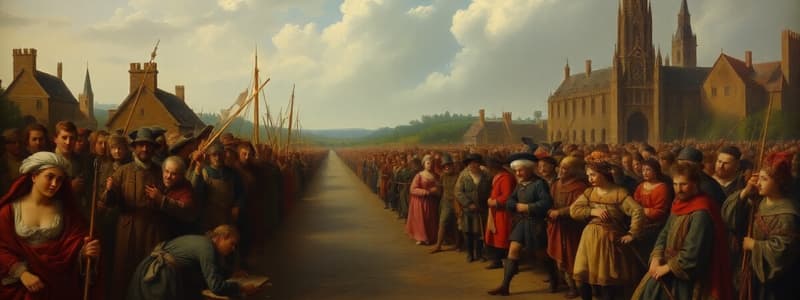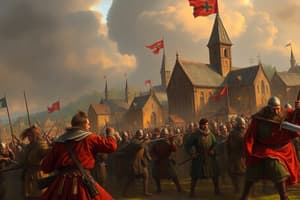Podcast
Questions and Answers
What was a significant consequence of the Peace of Augsburg in 1555?
What was a significant consequence of the Peace of Augsburg in 1555?
- It mandated that all German princes convert to Catholicism.
- It allowed religious conflicts to persist and eventually led to the Thirty Years' War. (correct)
- It permanently established Lutheranism as the sole religion in Germany.
- It united the German states under one absolute monarch.
Which monarch is known for building a strong military tradition in Prussia?
Which monarch is known for building a strong military tradition in Prussia?
- Louis XIV
- Maria Theresa
- Charles V
- Frederick the Great (correct)
What was the relationship between Catholic and Lutheran princes in the period leading up to the Thirty Years' War?
What was the relationship between Catholic and Lutheran princes in the period leading up to the Thirty Years' War?
- They formed alliances to secure peace in Germany.
- They were generally cooperative due to the Peace of Augsburg.
- They remained suspicious of one another and sought to gain followers. (correct)
- They collaborated to overthrow the absolute monarchy in France.
What was the main religious outcome each prince could decide according to the Peace of Augsburg?
What was the main religious outcome each prince could decide according to the Peace of Augsburg?
What factor contributed to the instability in Germany after the Peace of Augsburg?
What factor contributed to the instability in Germany after the Peace of Augsburg?
What military strategy did Gustavus Adolphus employ to shift the tide of war in his favor?
What military strategy did Gustavus Adolphus employ to shift the tide of war in his favor?
Which European region was significantly impacted by the Hapsburg triumph?
Which European region was significantly impacted by the Hapsburg triumph?
What type of monarchy were the Hapsburgs best characterized as during this period?
What type of monarchy were the Hapsburgs best characterized as during this period?
What event in 1618 is described as the spark that ignited tensions in Bohemia?
What event in 1618 is described as the spark that ignited tensions in Bohemia?
Which group was primarily involved in forming a united front against Ferdinand II?
Which group was primarily involved in forming a united front against Ferdinand II?
Which statement is true regarding Ferdinand II's relationship with the Protestant community in Bohemia?
Which statement is true regarding Ferdinand II's relationship with the Protestant community in Bohemia?
Which two factions joined forces amid rising tensions prior to 1618?
Which two factions joined forces amid rising tensions prior to 1618?
What role did the Hapsburg family play in the events leading up to the Protestant revolt?
What role did the Hapsburg family play in the events leading up to the Protestant revolt?
What was the primary concern of Bohemian Protestants under Ferdinand II's rule?
What was the primary concern of Bohemian Protestants under Ferdinand II's rule?
What was the result of the tensions that mounted over the years leading to 1618?
What was the result of the tensions that mounted over the years leading to 1618?
What event did Ferdinand's actions primarily contribute to?
What event did Ferdinand's actions primarily contribute to?
Which two ruling families were primarily involved in the conflict during the Thirty Years' War?
Which two ruling families were primarily involved in the conflict during the Thirty Years' War?
During which period did the majority of Habsburg triumphs occur in the Thirty Years' War?
During which period did the majority of Habsburg triumphs occur in the Thirty Years' War?
How were the Habsburg armies able to financially sustain their military campaigns?
How were the Habsburg armies able to financially sustain their military campaigns?
What was a significant outcome of the Habsburg victories during the early years of the Thirty Years' War?
What was a significant outcome of the Habsburg victories during the early years of the Thirty Years' War?
What was one of the strategies used by Ferdinand during the early phases of the war?
What was one of the strategies used by Ferdinand during the early phases of the war?
What was a consequence of Ferdinand's army's path through German territories?
What was a consequence of Ferdinand's army's path through German territories?
Which of the following statements best describes the Thirty Years' War?
Which of the following statements best describes the Thirty Years' War?
What factor characterized the early successes of the Habsburg armies?
What factor characterized the early successes of the Habsburg armies?
What was a primary challenge faced by the German Protestant princes during the Thirty Years' War?
What was a primary challenge faced by the German Protestant princes during the Thirty Years' War?
Flashcards are hidden until you start studying
Study Notes
The Thirty Years' War: A Clash of Monarchs
- The Thirty Years' War (1618-1648) was a complex conflict that divided Europe, primarily over religious beliefs and power struggles between monarchs.
- The Peace of Augsburg (1555) attempted to settle religious differences by allowing German princes to choose their territory's faith, but ultimately failed to resolve tensions.
- The war was ignited by the Bohemian Revolt in 1618. The Protestant rebellion against Ferdinand II, the Catholic Holy Roman Emperor who sought to impose his faith on Bohemia, sparked conflict.
- The war can be divided into two phases: Hapsburg Triumphs (1618-1630) and Hapsburg Defeats (1630-1648).
- During the early phase, the powerful Habsburg army, supported by Spain, crushed the Czech uprising and defeated German Protestants.
- However, in 1630, the tide shifted with the intervention of Gustavus Adolphus of Sweden, who led skilled Protestant forces and significantly changed the war's course.
- Richelieu, a French Cardinal and influential ruler of the time, saw the war as an opportunity to weaken Habsburg power and sought to extend French influence.
- French involvement was significant, as they provided crucial funding and military support to the Protestants.
- The Thirty Years' War concluded in 1648 with the Peace of Westphalia, which marked a turning point in European history:
- It formally ended the religious conflict and established a system of state sovereignty, allowing rulers to determine their territories' religions.
- This treaty ushered in a new era with a focus on state power and diplomacy.
- The war had devastating consequences for Europe, leaving millions dead and bringing widespread destruction.
- Despite its brutality, the Thirty Years' War laid the groundwork for a shift in the balance of power in Europe, ultimately contributing to the rise of nations like France and Prussia.
Studying That Suits You
Use AI to generate personalized quizzes and flashcards to suit your learning preferences.




